|
|


|
| Life
along the Nile river as it cut through the desert waste of Egypt was
very much like contemporary Sumerian life. For survival's sake,
the cooperative life was essential. Authority was needed to
organize the building of irrigation canals and the allotting of water
rights. And under proper political organization life was
abundant. Life outside of such social organization was
unthinkable. The surrounding desert isolated – but also protected – Egyptian culture. In thousands of years of existence, seldom was ancient Egypt seriously challenged by outside armies. This too enabled Egypt to flourish generation after generation, retaining its essential cultural character with relatively little change over its long history. The First and Second Dynasties
(c. 3100 - 2890 BC and 2890 - 2686 BC) Very early (prior to 3150 BC) there were two ‘Egypts’: 1) Upper Egypt along the narrow Nile valley to the south, with its center at Thebes, and 2) lower Egypt along the wider fluvial and delta plains in the north, centered on Memphis. But in the period between 3200 and 3100 BC Narmer (Greek: Menes) forcibly united the two Egypts into a single kingdom – himself becoming the first ‘Pharaoh. The Old Kingdom (c. 2650 - 2150 BC)
The very advanced organization of agriculture along the Nile afforded by the newly unified Egypt permitted a very high level of material and social development for most of the next 1000 years. The Egyptian state was served by a very capable corps of civil administrators who oversaw monumental public works, such as the great pyramids at Gizeh. Egypt marked huge advances in not only agriculture and civil architecture but also science, medicine and civil law – affording a long reign of prosperity and peace. The Fourth Dynasty (c. 2600-2480) in fact was such a time of peace and prosperity that it ise viewed as something of a 'Golden Age' for Ancient Egypt. This was the time of the building of the great pyramids and the Great Sphinx at Giza (near modern Cairo). But eventually the expense of running such a huge state enterprise overtaxed the abilities of the pharaohs – resulting in the gradual transfer of power from the pharaohs to local governors . Agriculture suffered and the country began to experience periods of both famine and civil conflict. Thus the Old Kingdom succumbed to the chaos and Egypt entered an 140-year period known as the First Intermediate Period in which effective rule of Egypt was no longer held by the pharaohs but by local rulers. The Middle Kingdom (c. 2000 - 1650 BC)
Actually the First Intermediate Period put new life back into Egypt as economic and political competition strengthened at the local level. But this competition eventually brought forward new leaders – and in 2055 BC the Theban ruler Menuhotep succeeded in reuniting all of Egypt under his rule as pharaoh and founder of the 11th dynasty. Then with the rise around 1985 BC of the Egyptian ‘vizier’ (chief advisor to the pharaoh) Amenemhet, who went on to found an even more powerful 12th dynasty, Egypt found itself back in its former position of greatness, marking the beginning of the ‘Middle Kingdom.’ The irrigation system was fully restored, lost territory recovered, new mineral wealth exploited, and in general prosperity spread widely among the population. In fact the Middle Kingdom marks the development of a move of religious power from the lofty heights of the royal palace outward more broadly to the general society: i.e., the Egyptian religious focus on death and its earthly preparation and protection moved from a rather elitist affair to an issue shared widely by the general society. Egyptian religion became more ‘democratic’ in the Middle Kingdom. But toward the end of the 1700s BC Egypt entered another period of turmoil. Amenemhat III settled a number of nomadic people (the Hyksos), into the delta region of Egypt, hoping to exploit their labors to shore up what was a sagging economy. But the Hyksos soon took control of the delta region to rule it by their own right – forcing the retreat of royal power southward back up the Nile. By the mid 1600s BC the Hyksos had grown strong enough that their leaders even took the name ‘pharaoh’ for themselves as they established their own Egyptian ruling dynasty (the 15th dynasty). Meanwhile the weakness of Egypt proper was further compounded by the growing power of the Nubians or ‘Kushites’ to the South, further up the Nile. Traditional Egypt was in trouble. Egypt was now fully drawn into what is termed the Second Intermediate Period. For the next several centuries the Theban kings (the 16th dynasty) of Egypt were locked in a constant struggle with the Hyksos to the north and the Kushites to the south. The New Kingdom (1555 - 1078 BC)
Gradually native Egyptian rulers in Thebes (the 17th dynasty) were able to force back and then in 1555 BC defeat and end Hyksos rule, restoring Egypt to full unity – and paving the way for the 18th dynasty’s rise to power. The establishment of the 18th dynasty not only brought forward the New Kingdom, but also the most illustrious and longest reigning of the Egyptian dynasties. The 18th dynasty marks not only a new high point in Egyptian material culture – but a period of religious struggle as Egypt embraced the idea of monotheism in one form or another. The Pharaohs and the priests of Amun established Karnak as the center of a new monotheistic cult – which the young maverick pharaoh Akhenaten tried to suppress in making Aten the supreme god of Egypt (during the Amarna period). Eventually the priests of Amun were successful in restoring their god to prominence – and nearly obliterating the memory of the pharaoh Akhenaten and the god Aten. But the inability of the last pharaohs of the 18th dynasty to produce an heir brought forth in 1279 BC a new dynasty (the 19th) under a strong military ruler who took the name Ramesses (or Rameses) II – known to history as Ramesses the Great. He was not only the master builder of Egypt but, in contrast to the previous pharaohs, the father of numerous children. His rule was long and successful – stretching to nearly the end of the 1200s (ca. 1213) BC and reaching all the way up the Mediterranean coast into Syria. But troubles were beginning to mount for Egypt. The desert raiders from Libya and the ‘Sea Peoples’ from the Mediterranean in the north began to attack Egypt with regularity around this time (the Sea Peoples mentioned in Egyptian records were probably Aryan invaders from Asia – or Greeks, displaced in their homelands by these Aryan invaders). In the years following Ramesses II, Egyptian politics disintegrated into infighting and corruption – especially with the growth of power and political control of the priests of Amun. The Third Intermediate Period (c. 1078 - 653 BC)
This marks the beginning of the Third Intermediate Period with the northern part of Egypt under the hand of weak or foreign (Libyan) pharaohs and the southern half of Egypt under the rule of the priests of Amun – and all of Egypt under constant attack from all directions (including the Kassites from the South). For four centuries Egypt struggled under the burden of political corruption and warfare. Toward the end of this period (mid 600s BC) the Assyrians invaded Egypt and sacked the temples of Thebes. The Late Period (653 - 332 BC)
But typically, the Assyrians set up a local ruler – who would eventually use his power to turn against Assyria: in 653 BC Psamtik I (with the help of Greek mercenaries) successfully broke from Assyrian rule and established a strong new central authority – which brought a new round of economic and cultural growth to Egypt. However Egyptian independence was short-lived. In 525 BC the Persians, under Cambyses II, began to bring Egypt under Persian rule (Cambyses placed the country under the rule of a Persian satrap but took for himself the title of Egyptian pharaoh). Numerous Egyptian rebellions proved less successful against the Persians than it had been against the Assyrians. But eventually Persian rule came to an end when a new power, the Greeks and Macedonians under Alexander, took control of Egypt in 332 BC Egypt at this point not only became part of another foreign empire, but found itself under such serious Greek cultural domination that Greek culture would displace most of the Egyptian culture that had previously survived through thousands of years. Ancient Egypt had come to an end. |

|
|
The ancient Egyptian understanding of creation
In common with other religious systems of the ancient Near East, the Egyptian story of the creation of the heavens and the earth begins with watery chaos. Out of the watery chaos emerged the sun god Atum (or Amun-Re or Re: identified as the god with the falcon's head). It was he who emerged every morning from the underworld to sail across the sky until the evening--when he returned to the underworld. He in turn created numerous gods of air and water. Nut, the sky goddess, was a daughter of Atum and one of his created gods. Geb, her brother, was the earth god and also her husband. The Egyptian pantheon
Egyptian religion focused heavily on death – perhaps even more importantly than life, for the former was eternal in its scope. Prominent among the gods presiding over human life and death was
Priests and Pharaohs in conflict
With the spread of religious privilege from the ruling class to the broader reach of the people, the role and power of the temple priests expanded as well. By the time of the New Kingdom the pharaohs and priests (in particular the priests of Amun) were often in direct conflict with each other as the priests claimed as direct a line to the power of heaven (presided over by their god Amun) as the pharaohs. Akenaten's failed effort at instituting monotheism - c. 1340 B.C.
The pharoah Amenophis IV, discontent with the power and corruption of the traditional priesthood, attempted serious religious reform by destroying all references to any gods except the one god, Aten, the sun god. He took for himself a new name, Akenaten, built a new capital and busied himself with his religious reforms – not paying attention to either the foreign enemies of Egypt or his personal domestic enemies. His monotheism never took root among the people and after his death all his work was undone. This may have been in the part the reason that Akhenaten attempted to displace Amun worship with Aten worship (and took for himself the name Akhenaten). In any case his "revolution" did not outlive him and Amun worship – and priestly power of the priests of Amun – continued. The pyramids
To protect the slumber of the deceased, great mounds of stone, eventually evolving in their construction into pyramids, were built over prominent Egyptians' burial sites. The first ("step") pyramid was built under the guidance of the grand architect, Imhotep, for the pharaoh Zoser ca. 2750 BC. A century later Khufu (Greek: Cheops) began the building at Giza of the Great Pyramid as well as the Sphinx. |

|
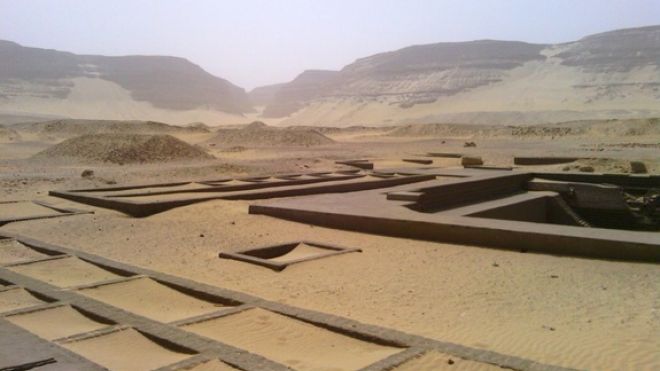
Monumental tombs of the Royal
Cemetery at Abydos, Upper Egypt,
where the First Dynasty
kings of Egypt are buried (c. 3100-2800
BC)
Palette of Narmer (King of
Upper Egypt): Triumph of the Peoples of the Delta
1st Dynasty - shale
Cairo, Egyptian Museum
Pyramid of Djoser, Saqqarah – 3rd Dynasty (c. 2660 BC)
The Great Pyramids of Giza
The Great Sphinx and two
of the three Great Pyramids of Giza
(just outside Cairo) built
during the Old Kingdom
The Sphinx and the Pyramid
of Khafre, Giza – 4th Dynasty (c. 2600-2480 BC)
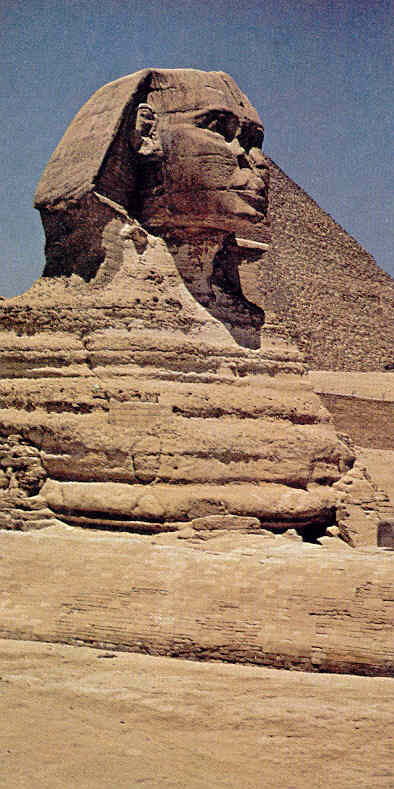
The Great Sphinx near the
Great Pyramid at Giza
Geese – detail of
a tomb painting from the mastaba tomb of Nefermaat at Medum
(4th Dynasty: c. 2680-2500)
Statues of Rahotep and Nofret
– beginning of the 4th Dynasty (c. 2600 BC) painted limestone
from the mastaba of Rahotep,
Maydum
Cairo, Egyptian Museum
Triad of Menkaure (between
the goddess Hathor and the goddess protecting
the "nome" [district] of
Cynopolis – 4th dynasty (c. 2600-2480 BC)
Cairo, Egyptian
Museum
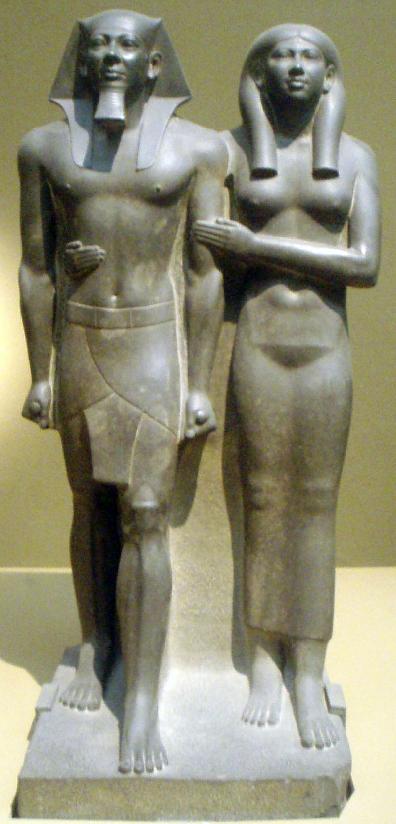
Menkaure and his sister-wife Khamerernebty
II
Boston, Museum of Fine
Arts
The Seated Scribe – 4th or
5th Dynasty (c. 2600-2350 BC) painted limestone from Saqqarah
Paris, Musée du Louvre
Two Sculptors
Working
on a Statue – Saqqara (5th Dynasty: c. 2510-2460 BC) painted stone
relief
Cairo, Egyptian
Museum

|
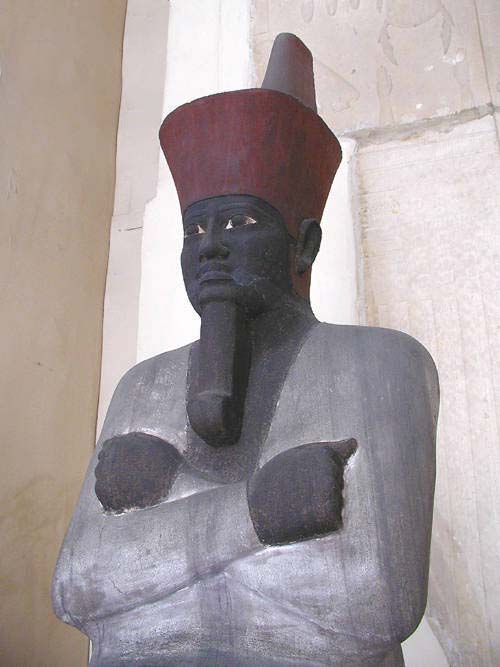
Pharoah Mentuhotep II (c. 2055-2010 BC)
first
pharaoh of the 11th Dynasty and the Middle Kingdom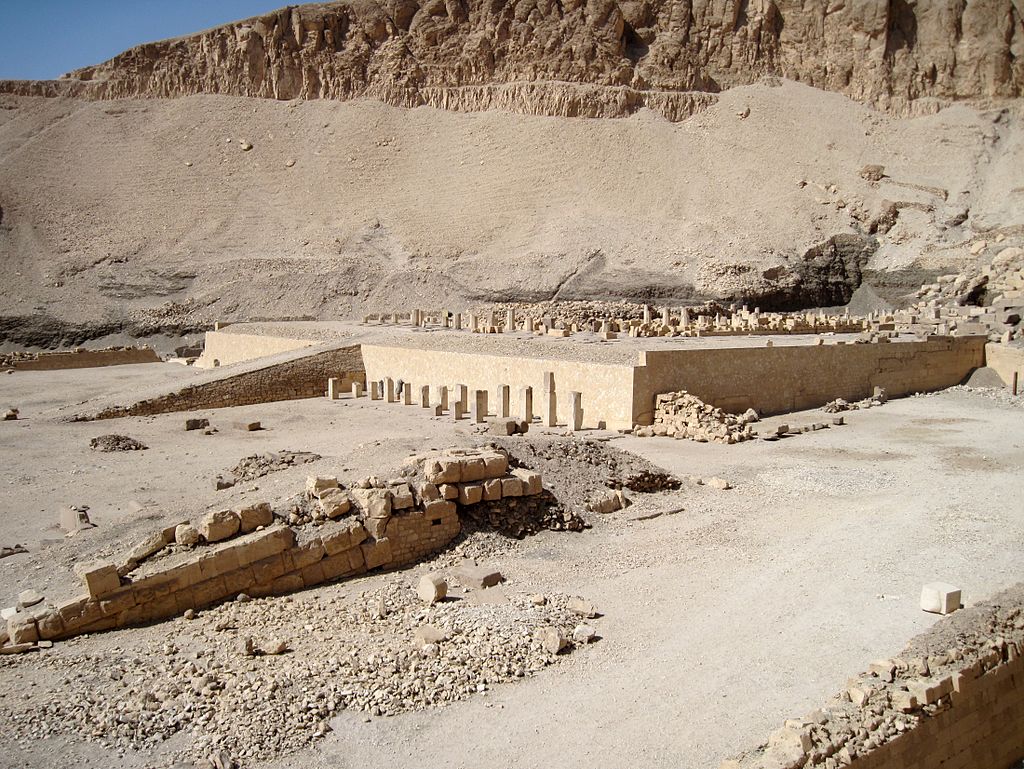
The remains of Mentuhotep II's burial site northwest of
Luxor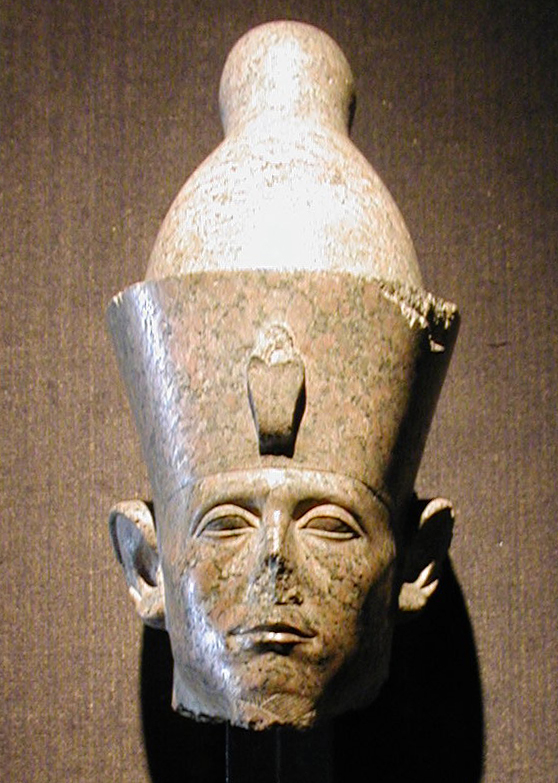
The powerful warrior-pharaoh Senusret III (reigned
1878-1839 BC)
Berlin, Altes
Museum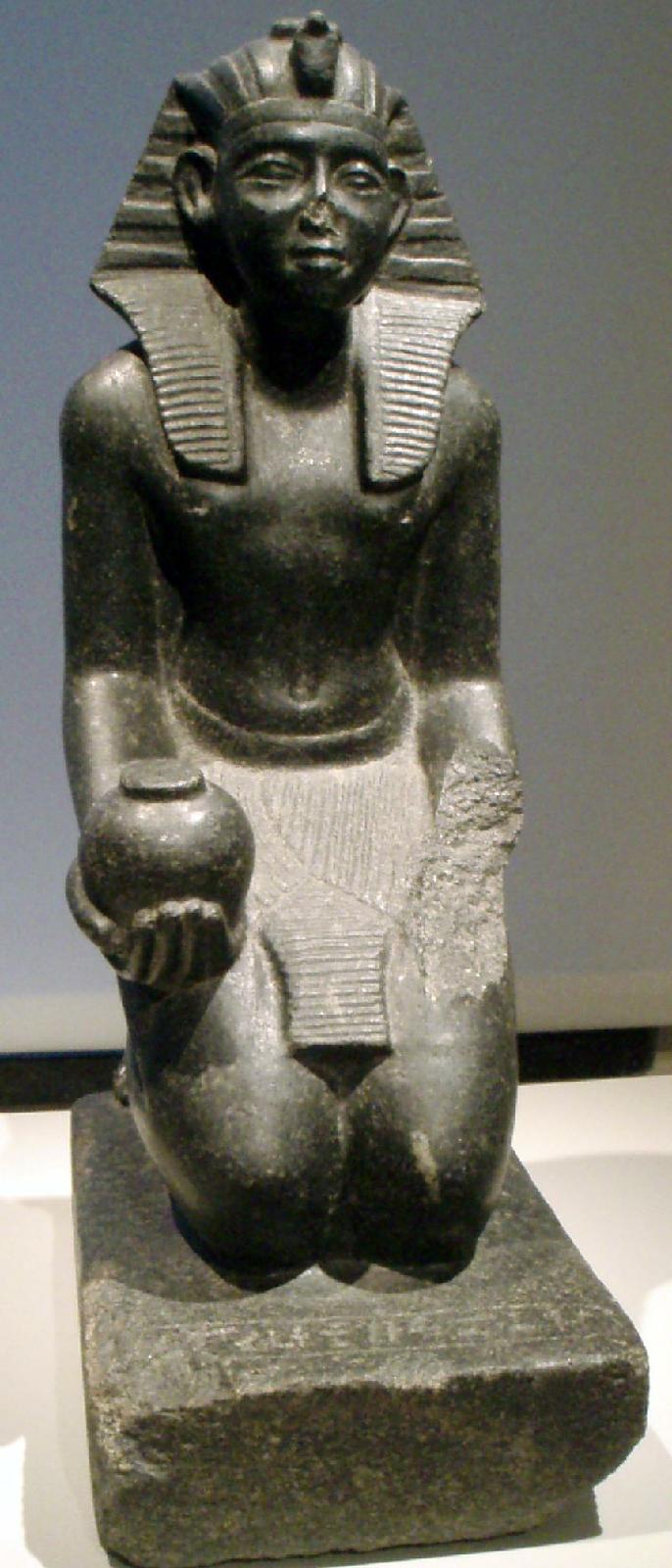
A kneeling statue depicting
the Pharaoh Sobekhotep V (c. 1750-1700 BC)
Berlin, Altes Museum

|
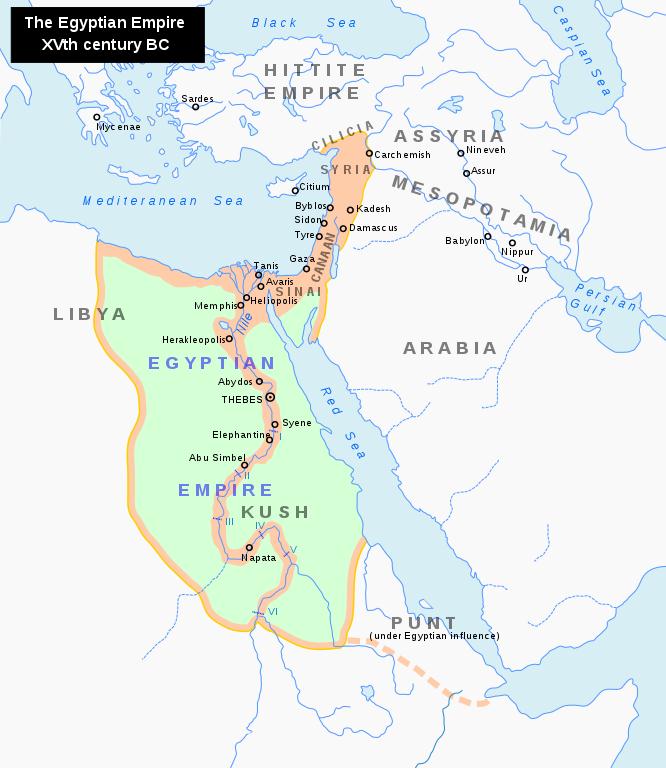
New Kingdom at its maximum territorial extent in the 15th century
BC
Wikipedia - "New
Kingdom
of Egypt"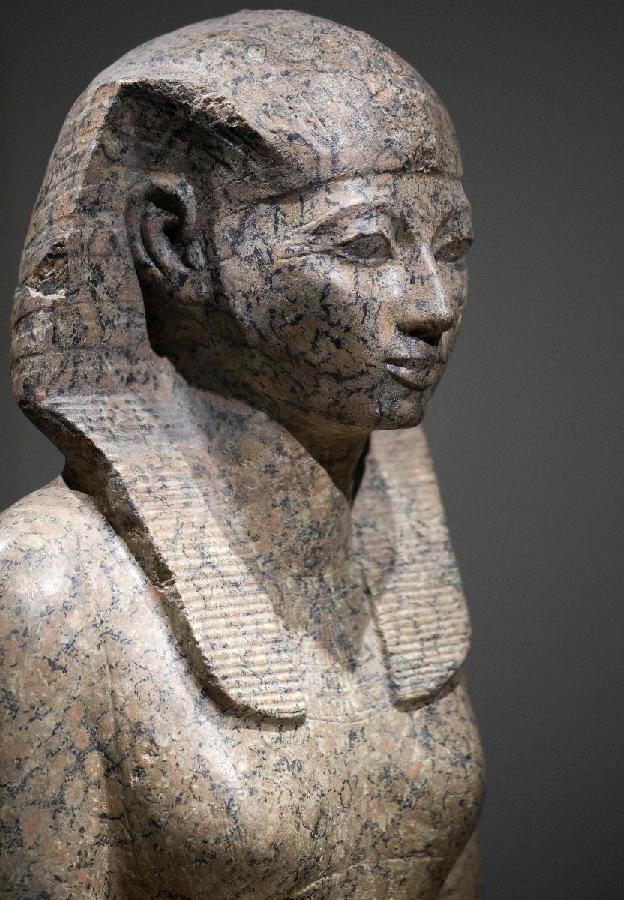
The female Pharaoh Hatshepsut (reigned c. 1478-1458 BC)
ruled
jointly - lengthily and well - with her son
(he was only a 2-year-old child at her accession to
power)
Leiden - Rijksmuseum
van Oudheden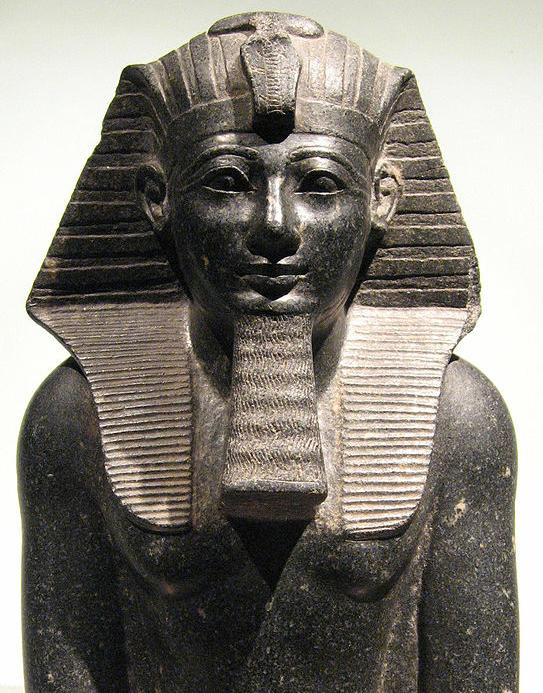
Thutmosis III (reigned 1479-1425 BC)
His conquests brought
Egypt's territory to its greatest extent
Vienna - The Kunsthistorisches Museum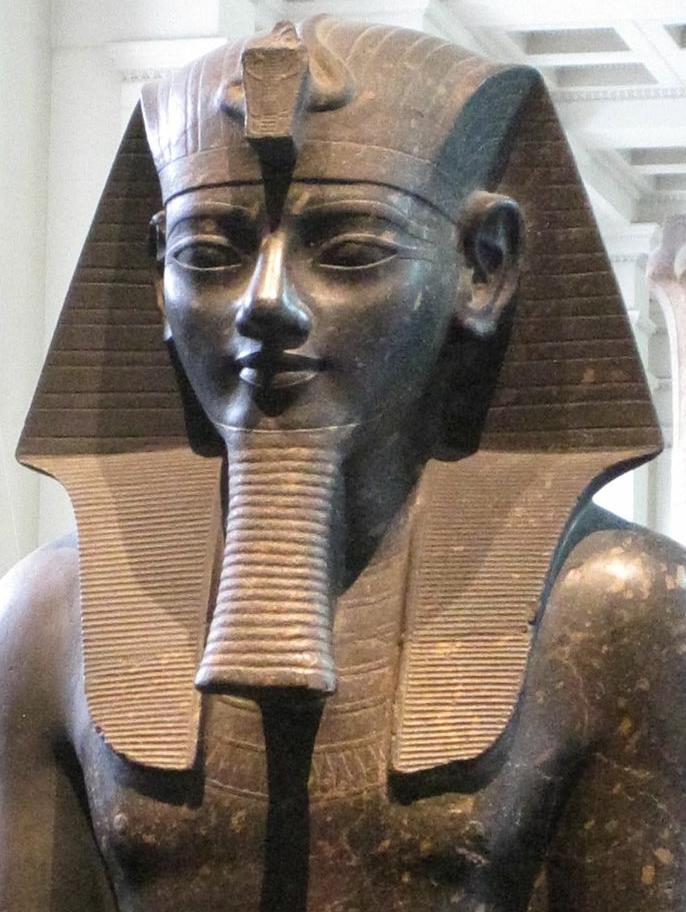
Amenhotep III (reigned c.
1390-1352)
He reigned during the height of Egyptian cultural
splendor
London. British
Museum
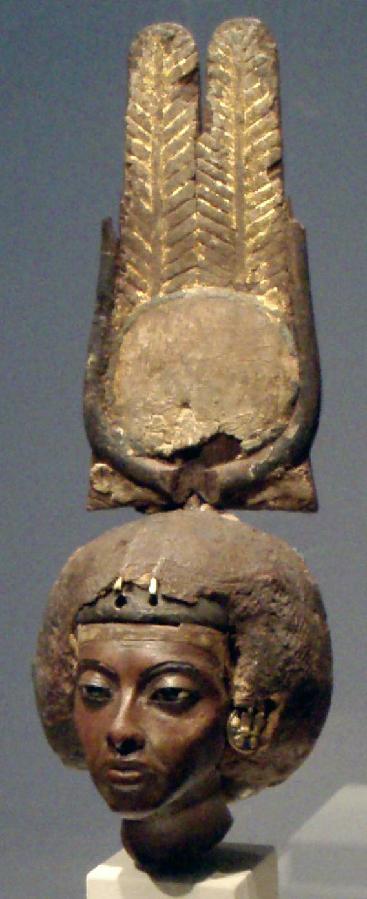
Queen Tiye (c. 1355 BC)
- although born a commoner,
she became wife of Amenhotep III
and mother of Amenhotep IV
(Akhenaten)
Berlin, Altes
Museum
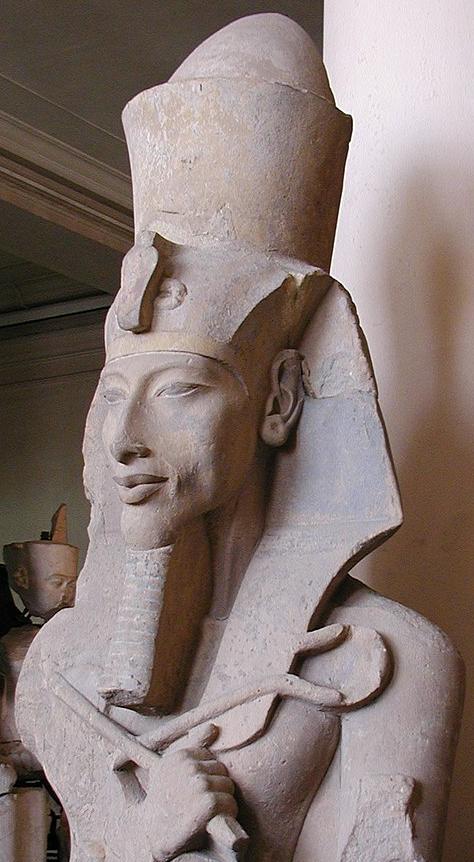
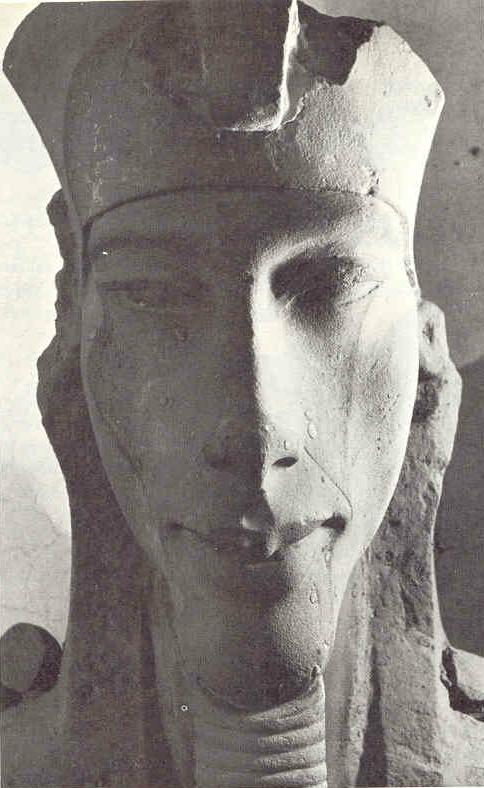
Amenhotep IV - son of Amenhotep III
and Queen Tiye ... who tried to shift Egyptian worship to Aten
(and thus also took the
name Akhenaten) reigned c. 1352-1336 BC
Head of Nefertiti (wife of Akhenaten)
– 18th
Dynasty (c. 1450-1310 BC) limestone
Berlin, Ägyptisches
Museum
Amenhotep IV, Nefertiti and
three of their daughters – 18th Dynasty (c. 1340 BC)
domestic altar from a house
in Amarna
Berlin, Ägyptisches
Museum

Golden funeral mask of king
Tutankhamun (son of Akhenaten and Nefertiti)
Cairo, Egyptian Museum
Throne of Tutenkhamen
(Ankhesenamen
oils the body of her spouse) – 18th Dynasty (c. 1326 BC)
wood covered in gold leaf
– from the tomb of Tutankhamen, Valley of the Kings, Thebes
Cairo, Egyptian
Museum
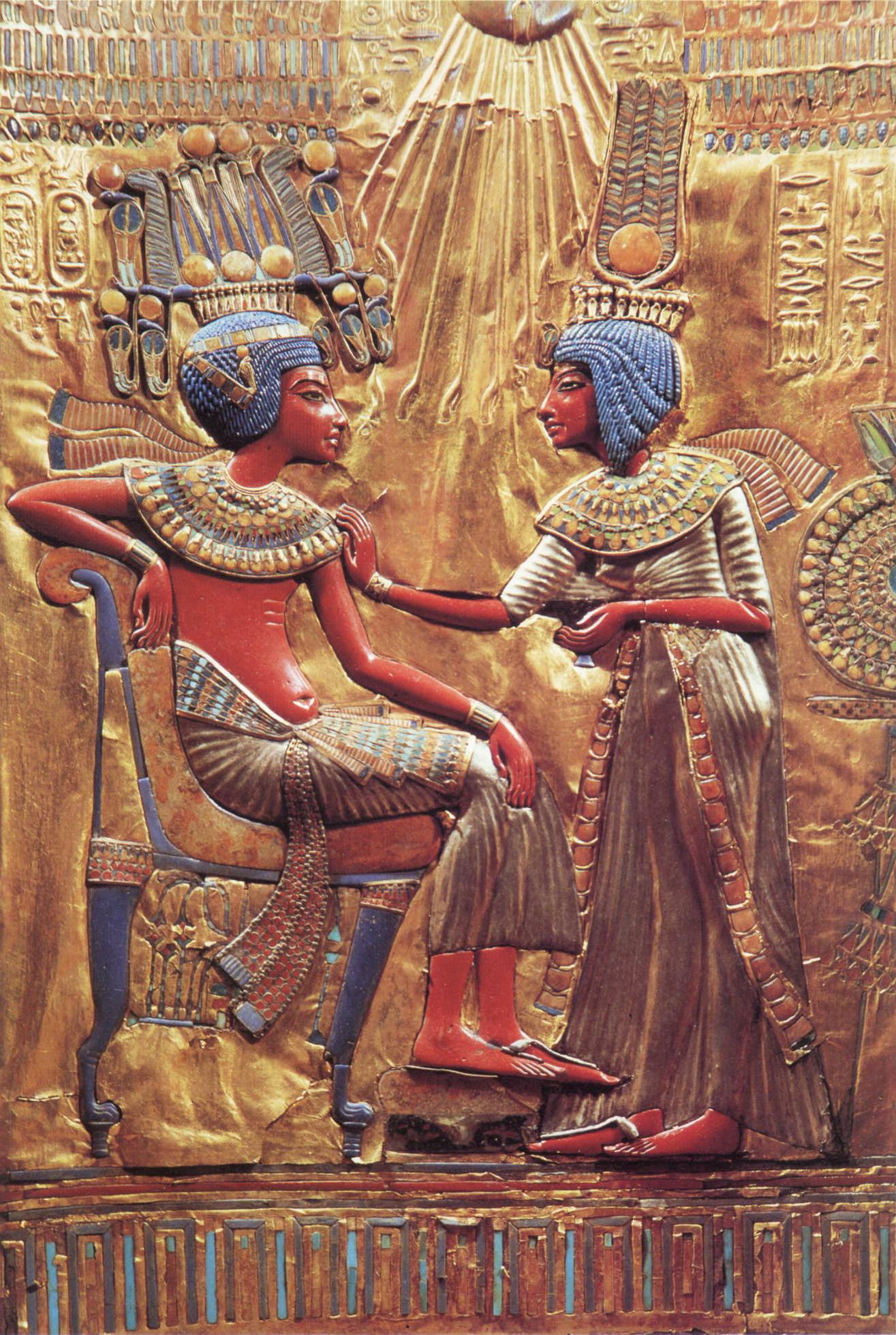
Tutankhamen with His Queen
Ankhesenamen
detail on the back of the throne of
KingTutankhamen,
from the tomb of
Tutenkhamen,
Valley of the Kings (c. 1355-1342 BC) carved wood
covered with gold and
inlaid
with faience, glass paste, semiprecious stones and silver
Cairo, Egyptian
Museum
Two Sacred Baboons – wall painting from the tomb of Tutankhamen, Valley of the Kings
(c. 1400-1350 BC)Goddess Hekhmet – 18th Dynasty (c. 1450-1310) diorite
probably from the temple of Mut, Karnak
Paris, Musée du LouvreNebamun Hunting Birds – fragment of a wall painting from the tomb of Nebamun
Drah Abu el-Neggah, Valley of the Nobles, Thebes-West
(18th Dynasty: c. 1400-1350 BC)
London, British Museum
Banquet Scene – Fragment of a wall painting from the tomb of Nebamun, Thebes
(18th Dynasty: c. 1400-1350 BC)
London, British Museum
Workers making brick – wall painting from a Theban tomb
Some workers are not Egyptian – perhaps the "apiru" ("Hebrew")
The Deceased Worshiping the Gods Osiris and Anubis – detail of the Stele of Nanai
(18th Dynasty: c. 1400-1350 BC)
Turin, Museo Egizio
Anubis, God of the Dead,
Leaning over Sennutem's Mummy – tomb of Sennutem in the cemetery
of
Deir el Medina, Luxor -Thebes (c. 1400 - 1350 BC)
Temple of Amon, Luxor – 18th Dynasty (c. 1340 BC)
(papyrus-shaped columns of the peristyle court of Amenhotep III)
19th Dynasty (1310-1200 BC)
Pharaoh Seti I and the
goddess Hathor (19th Dynasty: 1200s BC) painted relief
Florence, Museo
Archeologico
The Temple of Pharaoh Seti
I at Abydos
Ramesses II (or "Ramses II") The Great – son of Seti I
ruler of what is commonly considered to be the "height" of the Egyptian Empire
Egyptian Museum (Museo Egizio)
of Turin - Italy (photo by Aymeric Lopez)
Proposed facial reconstruction based on his actual mummified remains
Temple of Ramesses II – 19th
Dynasty (c. 1240 BC) sandstone – Abu Simbel
Temple of Ramesses II – 19th
Dynasty (c. 1240 BC) sandstone – Abu Simbel
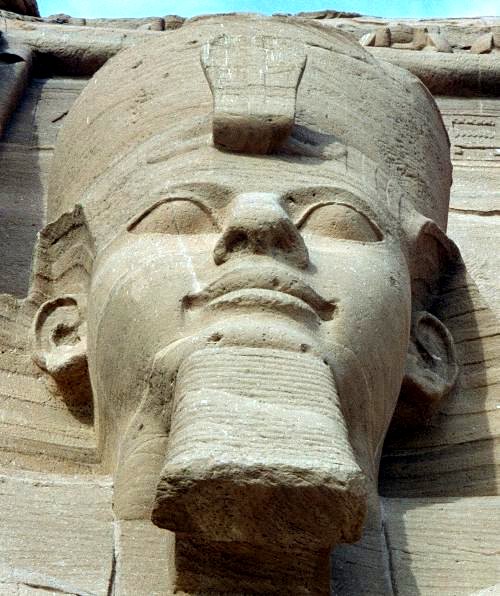
Ramesses II: one of four
external seated statues at Abu Simbel
Ramesses II storming the Hittite fortress of
Dapur (1269 BC)
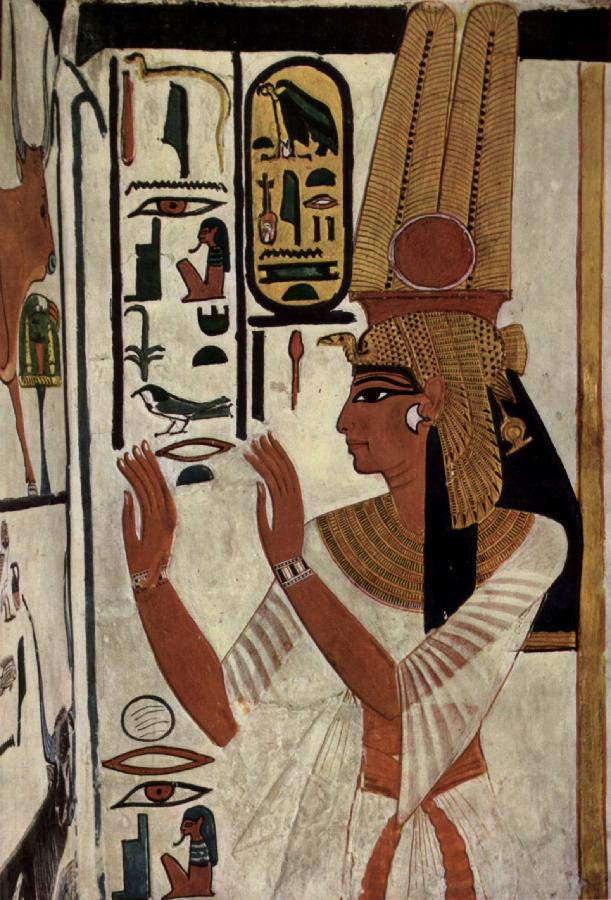
Nefertari (wife of Ramesses II)
The court of Ramesses II, added
to the temple of Amon at Luxor
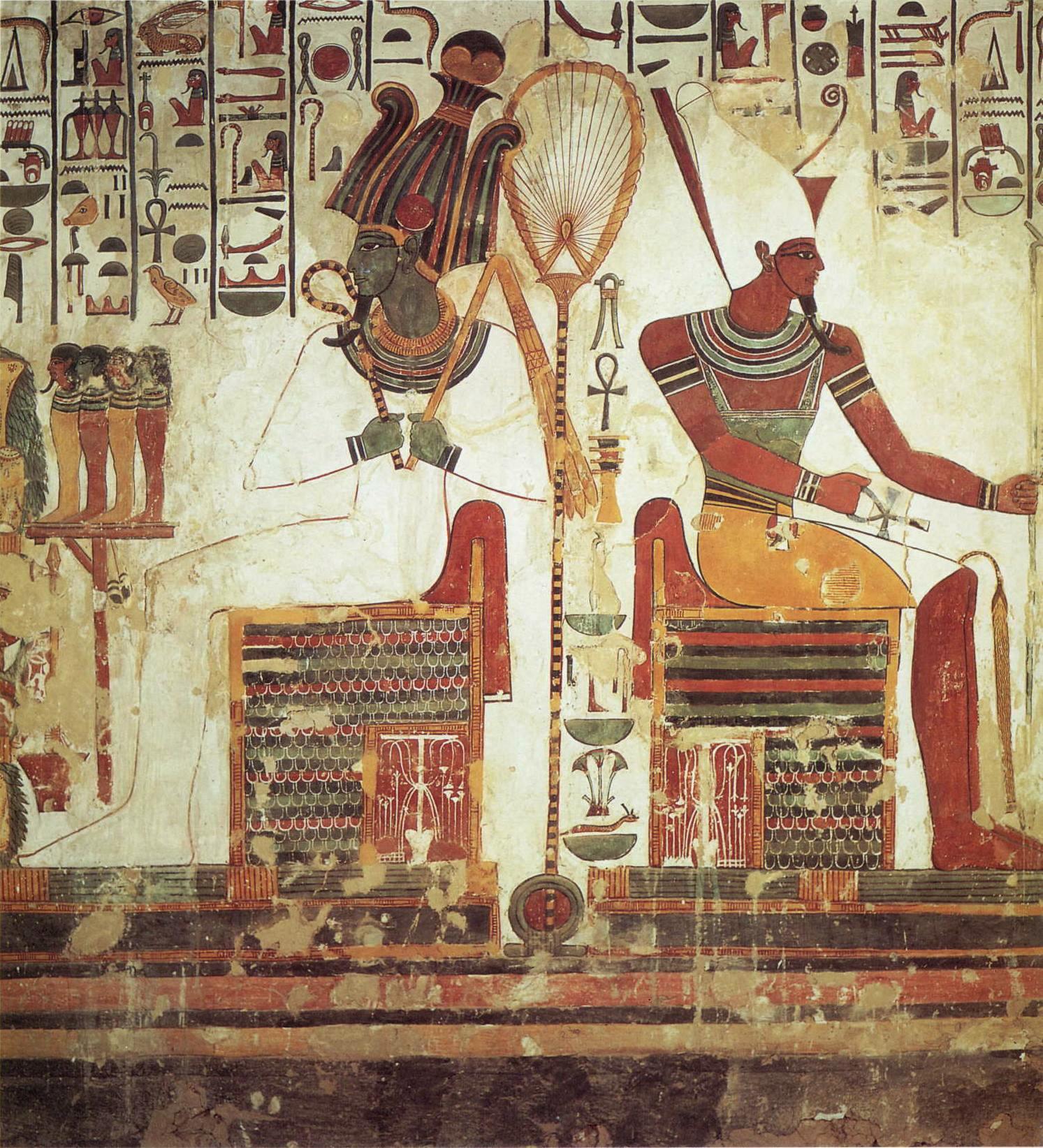
The gods Atum and Osiris
– wall painting from the tomb of Nefertari (wife of Ramesses II)
(19th Dynasty: 1200s BC)
Valley of the Queens, near Deir el-Bahri
Alley of sphinxes with rams' heads, Temple of Amon-Ra, Karnak – 19th dynasty (c. 1310-1200) sandstone
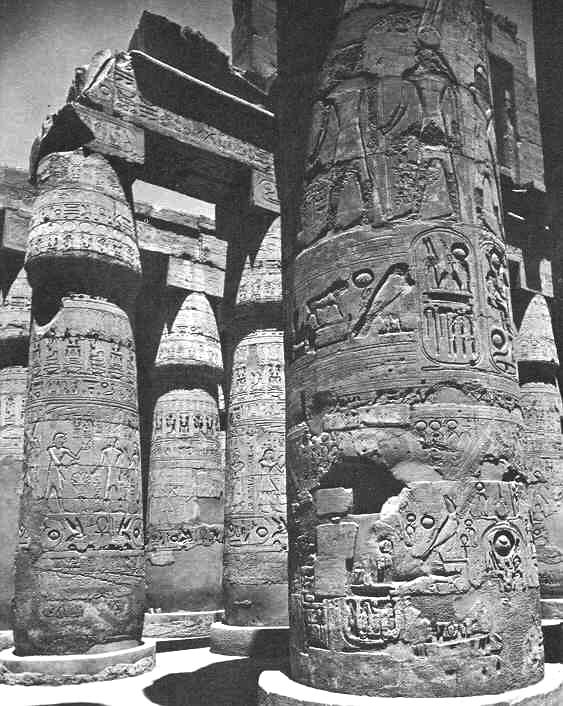
Karnak - Egypt
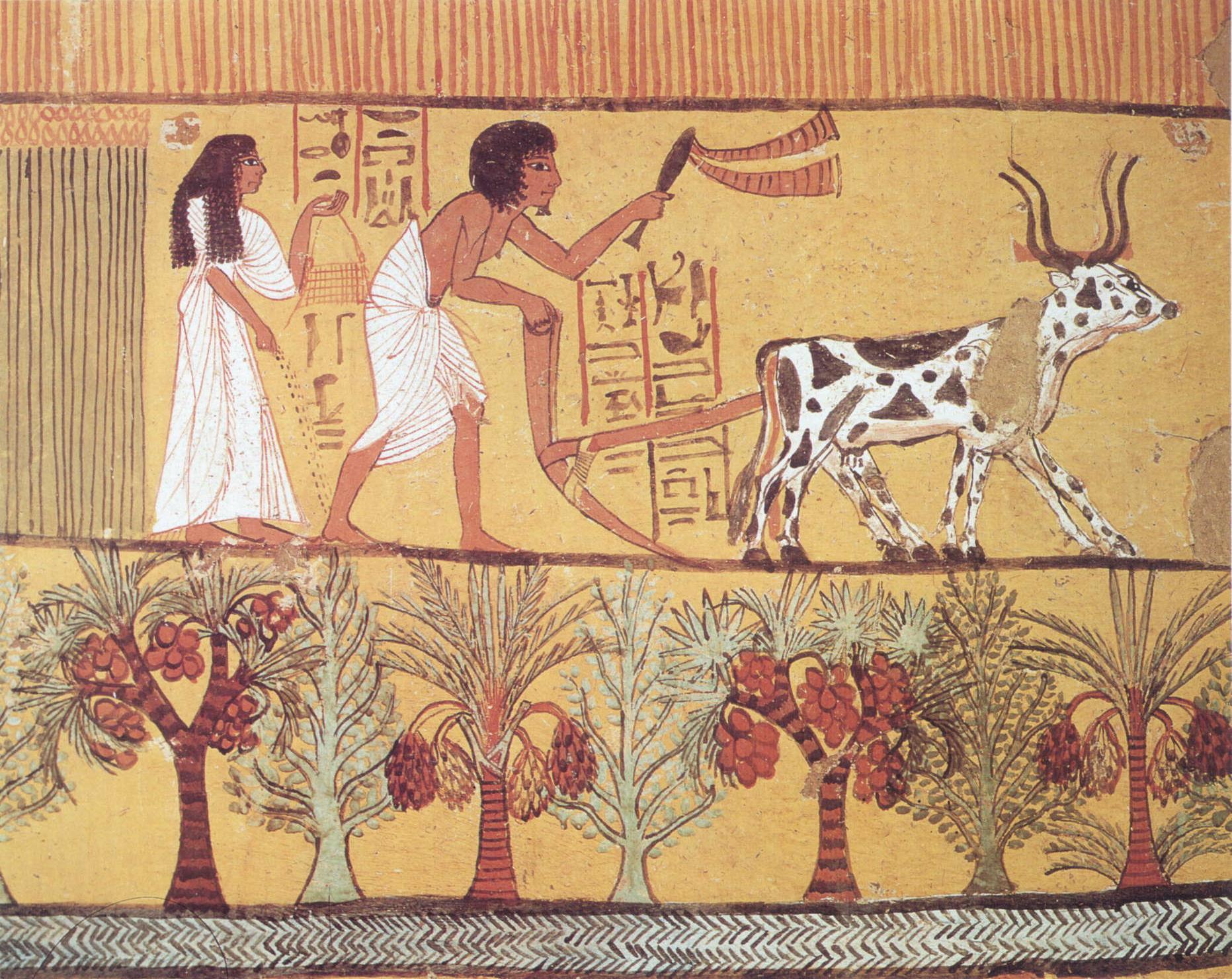
Sowing and Plowing in
the Fields – Tomb of Sennedjem, Thebes (19th Dynasty: 1200s
BC)
20th Dynasty (1200-1080 BC)
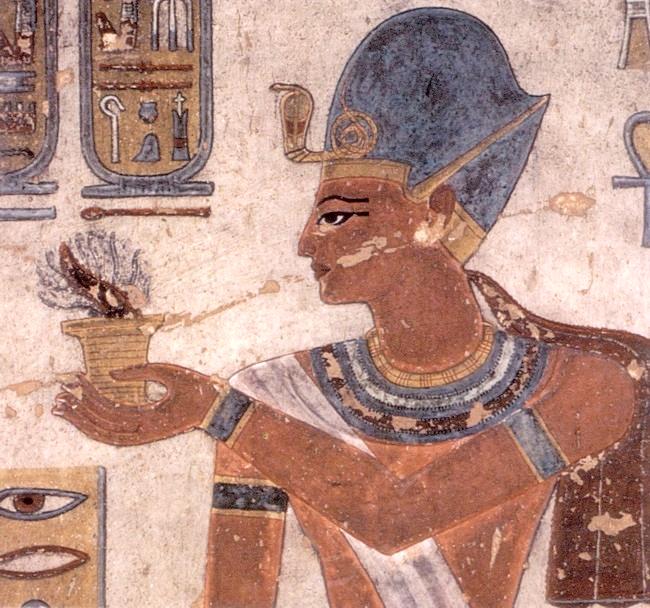
Ramses III (reigned 1186-1155 BC)
Egyptian
power declined during his reign – with Egypt under attack from abroad
(the Sea Peoples) and with economic troubles at home.
He was assassinated in a harem plot led by one of his
secondary wives and their son Pentawer
Scene on a temple wall depicting
Ramses III's victory over the "Sea Peoples" in the early 1100s BC.
The enemy may have been
the Philistines or the Achaean Greeks
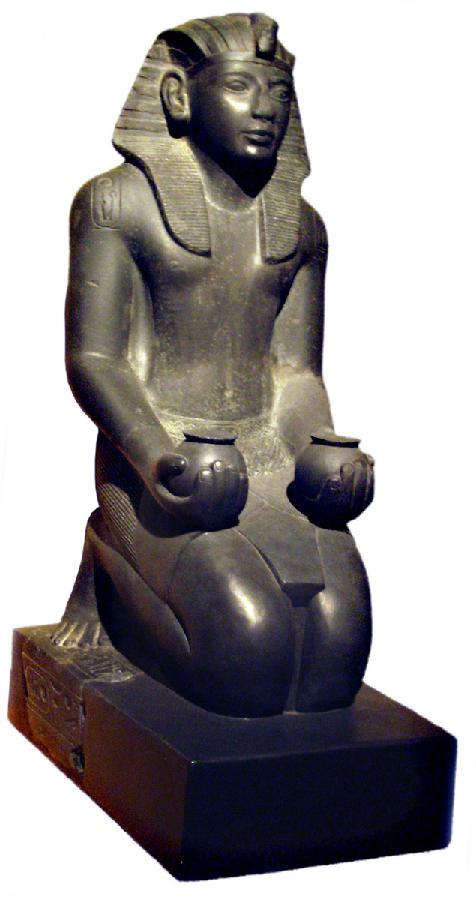
Ramses IV (reigned 1155-1149 BC)
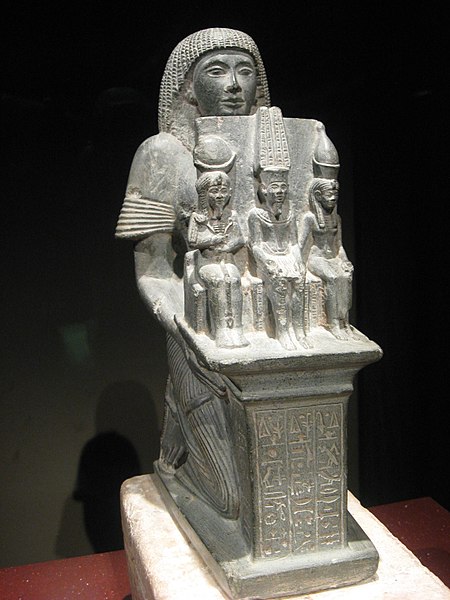
Ramessesnakht - HIgh Priest of
Amun at Thebes
He was appointed by Ramses IV (c. 1150 BC) and served all the way to
Ramses IX (c. 1120 BC?)
This marks the beginning of the long period of dominance of
Egyptian life by the Amun priests
(ca. 1100 to mid-900s BC)
Anhour Khaou, Chief Builder
at Thebes, Seated with His Wife and Grandchildren
wall painting from the tomb
of Anhour Khaou, Thebes (20th Dynasty: 1200-1080 BC)
Acrobat – (20th Dynasty:
c. 1180 BC) limestone ostracon
Turin, Museo Egizio
Ceiling detail, hypogeum
of Ramses IV – 20th Dynasty (c. 1140 BC) Valley of the Kings,
Thebes-West
(two buttressing goddesses
representing the night sky and the daytime sky respectively)

|
26th Dynasty (c. 650-525 BC)
Pharaoh Psamtik I (ruled
664-610 BC)
He
was able to break the Kushite hold over Upper (southern) Egypt and then
shake off
Assyrian rule in Lower (northern) Egypt ... thus reuniting Upper and Lower
Egypt
and founding the 26th Dynasty (664-525
BC)
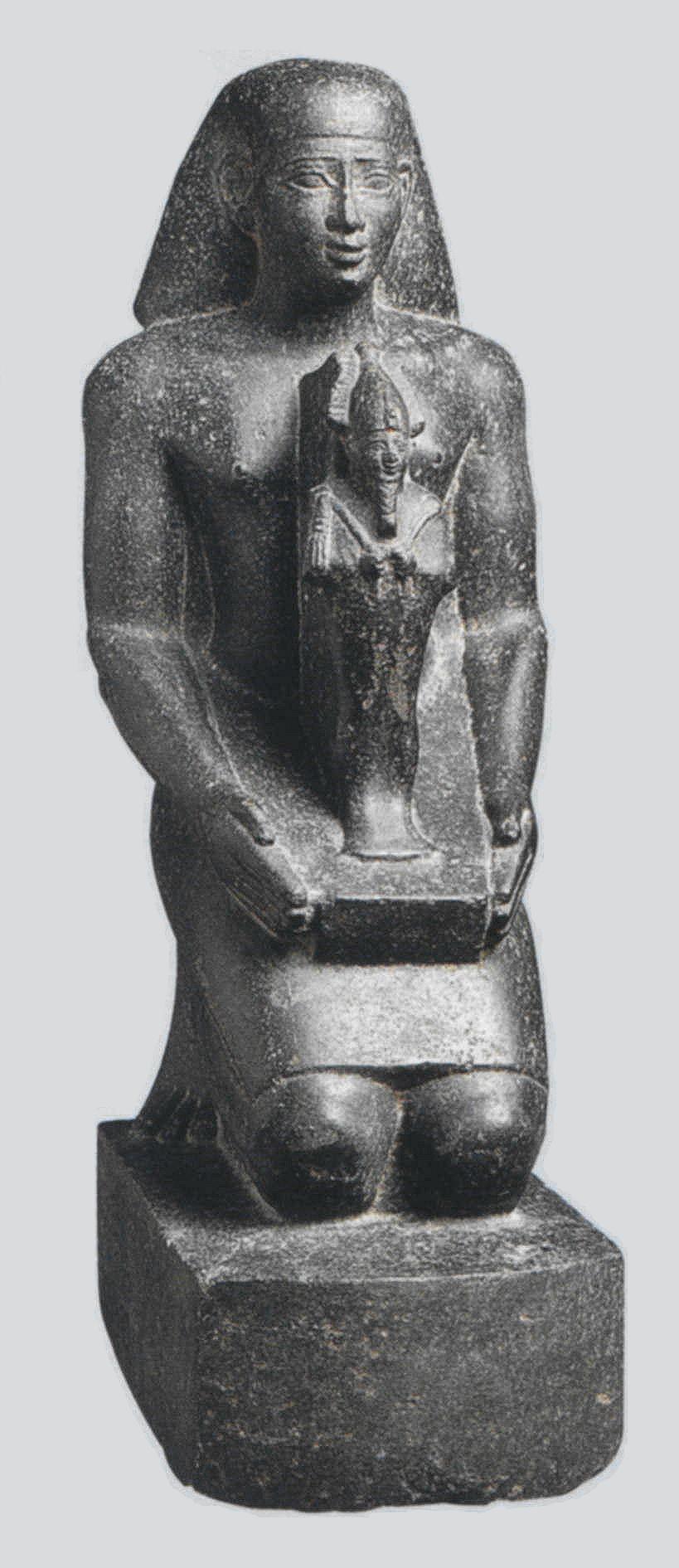
Pharaoh Psamtik II presenting Osiris – 26th Dynasty - diorite
Paris, Musée du Louvre
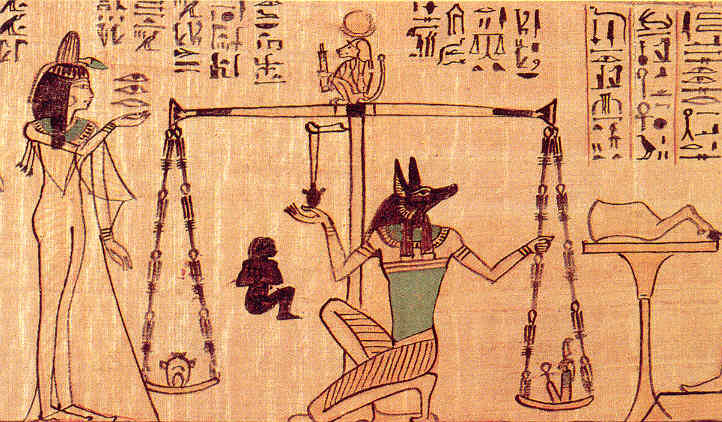
The god Anubis weighing a woman's heart against a figure representing truth.
A selection from the papyrus scroll Book of the Dead
Excavations of the Metropolitan Museum of Art, 1929; Rogers Fund, 1930
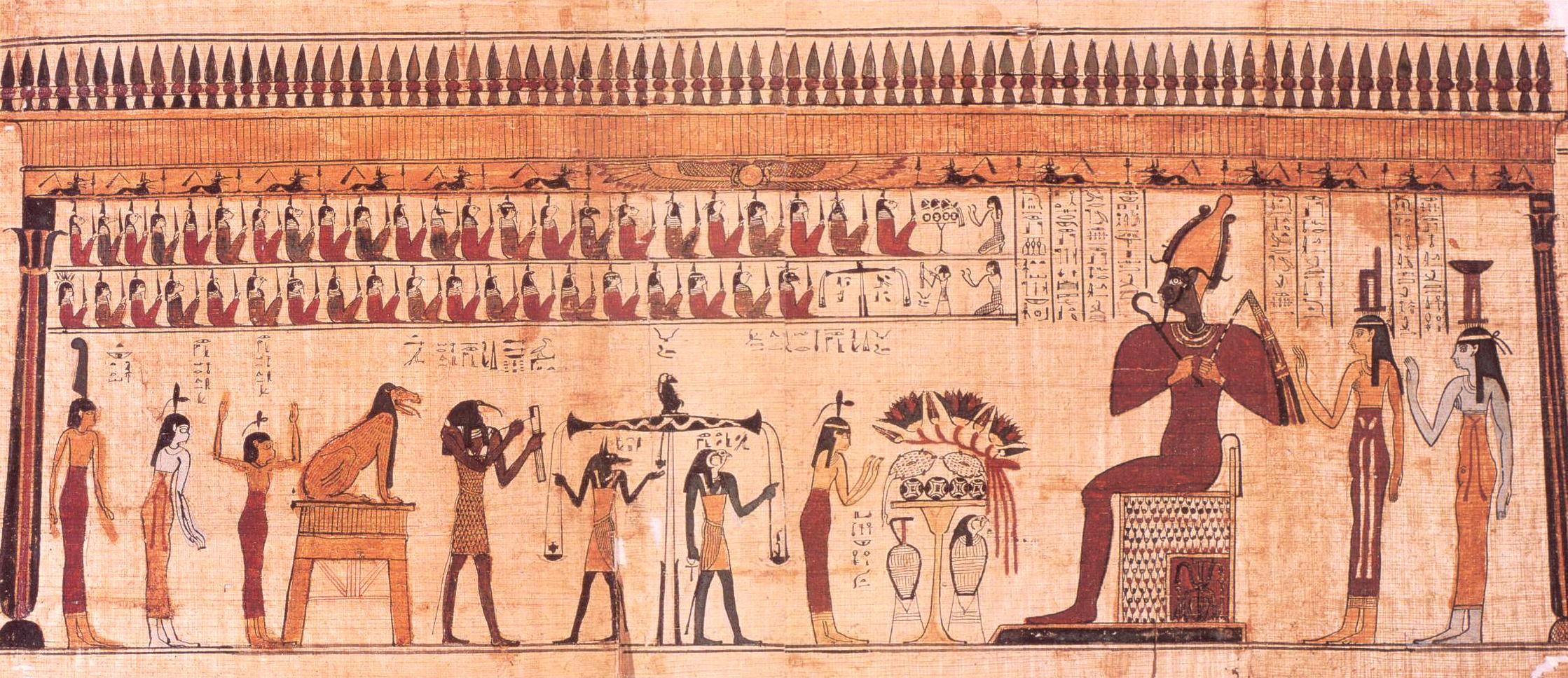
Judgment in the Other
World – Book of the Dead (c. 350 BC) papyrus
Berlin, Staatliche Museen,
Aegyptisches Museum
The Rosetta Stone and the Unlocking of Hieroglyphics


 Miles
H. Hodges
Miles
H. Hodges